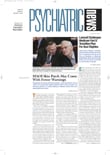The MAO-A gene, located on the X chromosome, helps people digest food containing amine groups such as serotonin and is involved in the metabolism of biogenic amines, including dopamine, noradrenaline, and serotonin. A short version of the gene that produces low MAO activity appears to play a role in antisocial behavior and to be the first gene strongly linked with such behavior.
In 2002, for example, Avshalom Caspi, Ph.D., of the Institute of Psychiatry in London and colleagues reported that maltreated boys producing this variant were more likely to develop antisocial problems than were maltreated boys who had a variant that produces high MAO-A activity. Debra Foley, Ph.D., of Virginia Commonwealth University and coworkers reproduced the finding in 2004 (Psychiatric News, September 3, 2004).
And now Kent Nilsson, a Ph.D. candidate at Uppsala University in Sweden, and his group have come up with the same finding, but with a twist.
When adverse psychosocial conditions were taken into consideration, the short MAO-A gene variant was no longer found to affect antisocial behavior. Thus it appears that the short gene variant primarily contributes to antisocial behavior when it interacts with adverse psychosocial conditions.
Some 4,000 teens living in Vastmanland County in Sweden were asked to complete a questionnaire in class that informed the researchers about which risk behaviors they engaged in—alcohol, drugs, sex, property offenses, and violent offenses. The investigators then asked the teens how many of them would be willing to participate in a scientific study and have blood drawn for it. Some 800 indicated that they would.
The researchers then selected 81 boys to participate in the study. They made sure that the boys were representative of the larger sample as far as deviant behaviors were concerned.
Each subject was then interviewed to determine whether he had ever engaged in antisocial acts—for example, fighting in school, driving while drunk, taking money or things that didn't belong to him, shoplifting, vandalizing things, hurting someone with a weapon—and if so, how often.
Each was also asked to describe his family and neighborhood, whether he lived in a single-family or multifamily residence (multifamily residence generally indicated low socioeconomic status in this particular group of subjects), and whether he had been beaten, sexually abused, exposed to threats, or otherwise maltreated.
A blood sample was taken from each subject, which was then analyzed for the kind of MAO-A gene variant he possessed.
Of the 81 subjects, 87 percent had committed at least one antisocial act. However, the police had taken only about one-third of them into custody for such behaviors, and only 14 percent of them more than once. Forty-one percent of the subjects had the short MAO-A gene variant that had been previously linked with antisocial behavior. Twenty-eight percent lived in multifamily residences. Fourteen percent said they had been maltreated.
The researchers then looked to see whether there was a significant link between subjects' total antisocial behavior scores and their possession of the short MAO-A gene variant. Such a link did appear, but only when possession of the variant was accompanied by unfavorable psychosocial conditions such as living in multifamily residences or having been maltreated.
In contrast, living in a multifamily residence and having been maltreated both predicted antisocial behavior independently of the short MAO-A variant.
Thus, “genotype and psychosocial factors interact to precipitate male adolescent criminal behavior,” the researchers concluded in their report, which is in press with Biological Psychiatry. However,“ I would say that according to our models the environmental effect is greater than the genetic effect,” Nilsson told Psychiatric News.
The study was funded by the Swedish Brain Foundation and the County Council of Vastmanland.
An abstract of “Role of Monoamine Oxidase A Genotype and Psychosocial Factors in Male Adolescent Criminal Activity” is posted at<www.journals.elsevierhealth.com/periodicals/bps/article/PIIS0006322305007754/abstract>.▪
